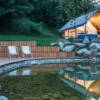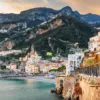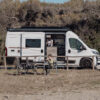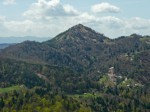And yet the province of Piedmont at the foot of the Italian Alps offers all of this. It is not unusual to talk about the miracles of Piedmont, since the capital of the province - Turin is famous for one of the greatest mysteries - the shroud, which is said to have wrapped the body of Christ after his death on the cross.
In 2006, Piedmont had its big moment with the Winter Olympics. The center of the action was Sestriere - a ski center between three and four thousand meters above sea level, which is just over an hour's drive from Turin. The elegant peaks that rise steeply towards the sky and the steep slopes are a wonderful environment for relaxation at any time of the year. Days in the mountains can be completed by visiting the cultural and gastronomic wonders of the province, visiting Romanesque churches, browsing antique shops or visiting tourist farms. Piedmont offers the past and the future at the same time, as it is famous as a highly developed and productive region in the constant development of new technologies, yet it maintains a rich natural heritage, which includes many cultural events that enrich leisure time. Piedmont is an Alpine province, as the name itself tells us - at the foot of the mountains - and at the same time it conjures up an image of a landscape dominated by one of Europe's highest peaks, covered with eternal snow. For example, Monte Rosa, which was already mentioned by Leonardo in his time, and Monviso, where the river Po originates.
Protected areas
The main asset of Piedmont's tourist offer is the Alps, Europe's longest mountain range. Two national parks: Gran Paradiso, protected in 1922, and Val Grande, established in 1992, are just two of Piedmont's natural wonders. In addition to them, visitors are also attracted by regional parks, for example Parco Alte Valli Pesio e Tanaro, famous for its limestone phenomena, Parco delle Alpi Marittime, the kingdom of granite, or Parco Orsiera Rocciavré, an oasis of wilderness near Turin. The region with its riches calls out for sports activities. Water sports, sailing or canoeing, the freedom offered by skydiving and the cliffs are ideal conditions for relaxation and fun. In winter, the alpine areas turn into the "white galaxy", a huge system dedicated to snow sports enthusiasts, which offers more than a thousand kilometers of pistes. Along the mountains of Piedmont, rivers also rule. Among the many rivers, torrents and streams, Piedmont is the birthplace of Italy's longest river, the Po. The second highest waterfall in Europe is 143 meters high in the Val Formazza valley. Among the lakes, the most important is the Great Lake (Lago Maggiore). The lake area of Lago Maggiore, Lago D'Orta and Lago Mergozzo is an ideal starting point for discovering the water riches of Piedmont. On Lago Maggiore, you can visit the Borromean Islands and admire the brilliantly landscaped gardens of Isola Bela and Isola Madre, or indulge in the romantic atmosphere of Isola dei Pescatori. But the search for a true water kingdom would not be complete without a visit to a glacier. In Valsesia, between the Monte Rose glaciers, we are offered one of the rare opportunities to explore the interesting history and development of glaciers. Many thermal springs have also been famous in Piedmont for centuries. Among them, the most important are: Acqui Terme, Agliano Terme, Garessio, Lurisia, Valdieri, Vinadio, Bognanco and Crodo.
A rich past
Piedmont is a region with extraordinary natural wealth, where the centuries have left an indelible mark: architectural and artistic heritage of inestimable value from Roman times to the present. Throughout the region, from smaller towns to the capital, we can admire palaces, villas, castles, forts, royal residences and sanctuaries, which are true architectural gems. But the most precious treasures date back to the Baroque period: the Residenze Savoy, the royal residences of the Savoyards in and around Turin, which were included in the UNESCO World Heritage List in 1997, and the Sacred Mountains (Sacri Monti), a group of chapels and buildings that were built in the 16th and 17th centuries in Piedmont and Lombardy and were included in the UNESCO list in 2003. The 19th century also left its mark, and Turin's rich heritage of bourgeois buildings, avenues and squares in the art nouveau style will remind us of this period. The city's symbol, La Mole Antonelliana, was also built during this time, a building with a distinctive roof built in 1889 that rises 167 meters high and remains the tallest building in Turin.
In the capital city
Piedmont hides many attractions, but we must also devote some time to the capital, Turin, which is famous as one of Italy's most important industrial centers (due to the Fiat factory), as well as for its football team and mortuary table. Thanks to the Olympic Games and the willingness of the people of Turin to offer visitors only the best, the city has modernized and turned into a lively cultural center, in which we can also enjoy one of the greatest gastronomic wonders - the wonderful EatItaly - a former factory converted into the largest store of culinary delights in Europe. Cafes, pubs, avant-garde architecture and hidden corners for friendly gatherings complete the image of Turin. To really feel the soul of the city, we must respect the tradition and try bicerin - hot chocolate with coffee and cream, served in the old pastry shop Al Bicerin in Piazza de la Consolata in front of the church of the same name. After a delicious bite, we can continue our walk along the lively Via Garibaldi to the baroque Piazza Castello, where there is a palace that was the seat of the influential Savoy dynasty. Coffee and an aperitif (the martini was "born" in Turin) are just two habits that are firmly rooted among the inhabitants. A cocktail or an aperitif before a meal is just as important as the meal itself, and a stop at one of the cafes is just as important as sightseeing. The most popular cafés are Mulassano, a real jewel of art nouveau architecture, Café Torino, one of the most elegant cafés in the city, and Café San Carlo, where the supporters of the Resorgiment gathered. Coffee connoisseurs often gather at San Tomaso 10, where they taste Lavazza coffee in a wide variety of versions, such as cappuccino with orange or tiramisu espresso. Cultural curiosity in Turin will be satisfied by a visit to one of the one hundred and thirty museums, but the Egyptian museum Egizio, which houses an archaeological collection with more than thirty thousand exhibits, should not be overlooked. The curious and the faithful from all over the world flock to the Museo de la Sindone on Via San Doménico to see the Shroud of Turin, which still stirs controversy about its origin and originality. Modern art is also richly represented in Turin, especially in the Pinacoteca Giovanni e Marella Agnelli, famous for its spectacular architecture and rich Matisse collection, and in the Gallery of Modern and Contemporary Art, which houses works by Picasso, Klee, Warhol and many Piedmontese artists. .






